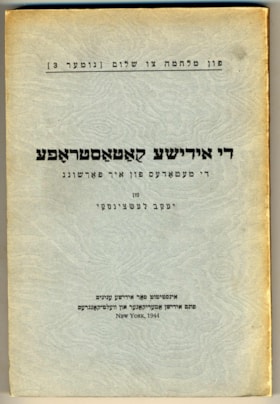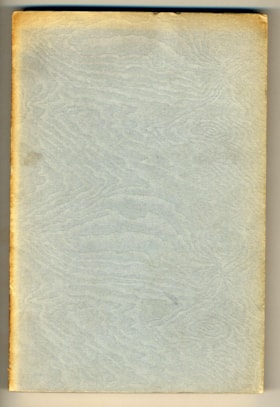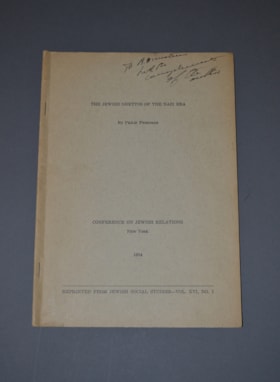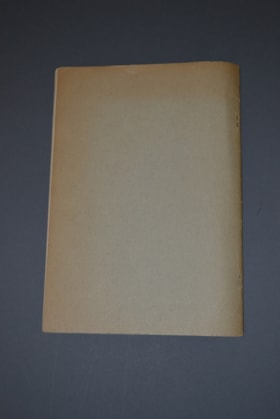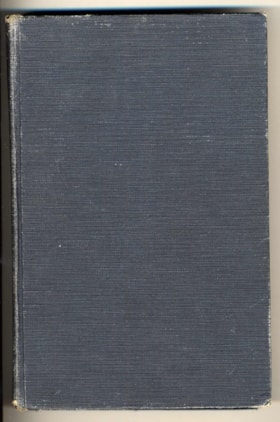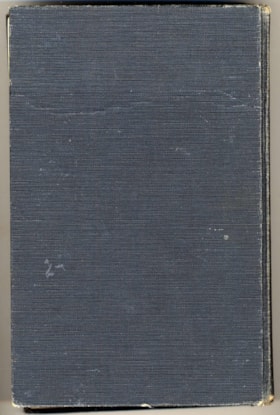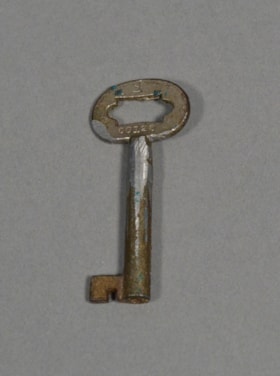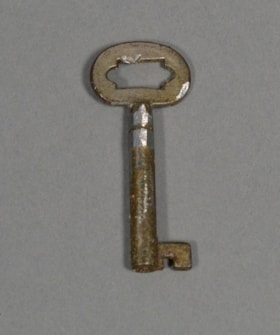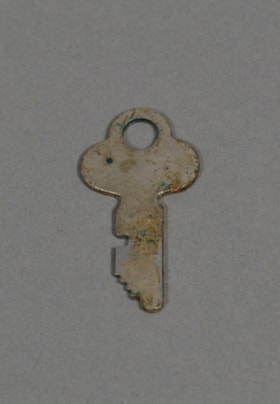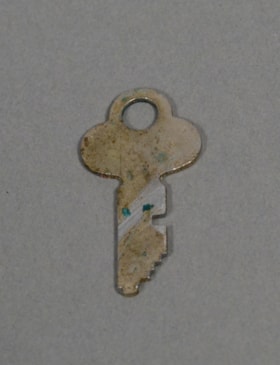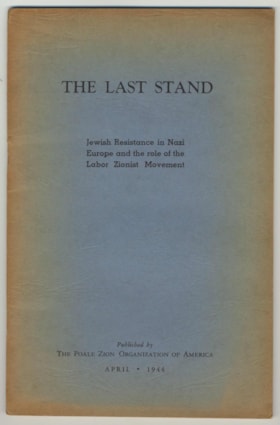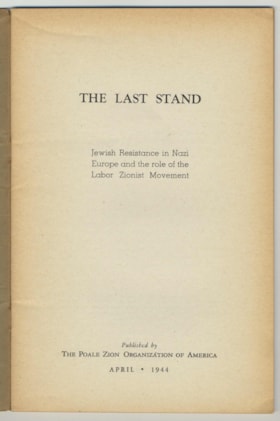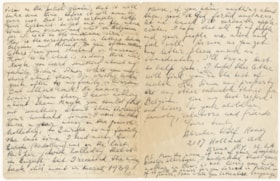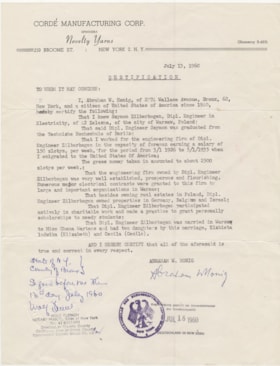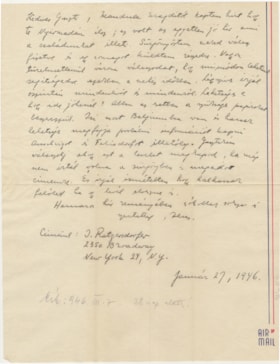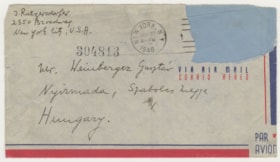Narrow Results By
Place
- Cleveland; New York, United States of America, North America 1
- New York, New York, United States of America, North America 1
- New York , United States of America, North America 1
- New York, United States of America (North America) 2
- New York, United States of America , North America 9
- New York, United States of America, North America 54
The Jewish Catastrophe (Translation)
https://www.cjhn.ca/link/cjhn47677
- Collection
- Montreal Holocaust Museum
- Description Level
- Item
- Material Type
- textual record
- Physical Description
- Book : printed, bound : grey, black, beige ; Ht: 22,4 cm x W: 15,2 cm
- Date
- 1944
- Collection
- Montreal Holocaust Museum
- Description Level
- Item
- Material Type
- textual record
- Physical Description
- Book : printed, bound : grey, black, beige ; Ht: 22,4 cm x W: 15,2 cm
- Other Title Information
- Documentary Artifact
- Date
- 1944
- Creator
- -
- Physical Condition
- Good
- Language
- English
- Yiddish
- Notes
- 239 pages. Softcover, paper bound. Cover is textured grey with black lettering; no text found on the spine or back cover. Interior pages are beige, with black text. The last cover, on the inside, has English text.
- Accession No.
- 2011X.58.141
- Name Access
- MHMC
- Archival / Genealogical
- Archival Descriptions
- Repository
- Montreal Holocaust Museum
Images
The Jewish Ghettos of the Nazi Era
https://www.cjhn.ca/link/cjhn48192
- Collection
- Montreal Holocaust Museum
- Description Level
- Item
- Material Type
- textual record
- Physical Description
- Booklet : printed, bound : beige, black ; Ht: 24,5 cm x W: 17,4 cm
- Date
- 1954
- Collection
- Montreal Holocaust Museum
- Description Level
- Item
- Material Type
- textual record
- Physical Description
- Booklet : printed, bound : beige, black ; Ht: 24,5 cm x W: 17,4 cm
- Other Title Information
- Documentary Artifact
- Date
- 1954
- Creator
- -
- Physical Condition
- Good
- Notes
- 27 pages. Softcover, bound with staples. Cover is beige, with visible fibres woven into the paper; black text. Pages are beige, with text: pages start at number 61 and end at number 88.
- Accession No.
- 2012X.73.01
- Archival / Genealogical
- Archival Descriptions
- Repository
- Montreal Holocaust Museum
Images
Jews Must Live: An Account of the Persecution of the World by Israel on all the Frontiers of Civilization
https://www.cjhn.ca/link/cjhn47426
- Collection
- Montreal Holocaust Museum
- Description Level
- Item
- Material Type
- textual record
- Physical Description
- Book : printed, bound, graphic arts : black, gold, beige, white ; Ht: 23,8 cm x W: 15,7 cm
- Date
- 1934
- Collection
- Montreal Holocaust Museum
- Description Level
- Item
- Material Type
- textual record
- Physical Description
- Book : printed, bound, graphic arts : black, gold, beige, white ; Ht: 23,8 cm x W: 15,7 cm
- Other Title Information
- Documentary Artifact
- Date
- 1934
- Creator
- -
- Physical Condition
- Good conservation
- Language
- English
- Notes
- 319 pages. Hardcover, cardboard bound with string. Cover is textured black fabric with no text; title is printed in gold along the spine, surrounded by a rectangular boarder; the back cover is blank. Interior pages are beige with text and b&w illustrations. The page before the title page is glossy white, with an illustration of a man in front of a black background. The book's title is printed along the bottom.
- Accession No.
- 2011X.41.10
- Name Access
- Orenstein, Benjamin
- Archival / Genealogical
- Archival Descriptions
- Repository
- Montreal Holocaust Museum
Images
Key
https://www.cjhn.ca/link/cjhn48026
- Collection
- Montreal Holocaust Museum
- Description Level
- Item
- Material Type
- object
- Physical Description
- Key : moulded, cut : silver
- Collection
- Montreal Holocaust Museum
- Description Level
- Item
- Material Type
- object
- Physical Description
- Key : moulded, cut : silver
- Other Title Information
- Household Accessory
- Physical Condition
- Good
- Notes
- Skeleton key with flat bow, an abstract hole cut out of the centre. The blade is cylindrical and hollow, with a tooth extending from the bottom edge: the tooth has a small rectangle cut out of the bottom edge.
- Accession No.
- 1990.78.59
- Name Access
- Worenklein, Sylvia
- Archival / Genealogical
- Archival Descriptions
- Repository
- Montreal Holocaust Museum
Images
Key
https://www.cjhn.ca/link/cjhn48154
- Collection
- Montreal Holocaust Museum
- Description Level
- Item
- Material Type
- object
- Physical Description
- Key : moulded, perforated, cut : silver
- Collection
- Montreal Holocaust Museum
- Description Level
- Item
- Material Type
- object
- Physical Description
- Key : moulded, perforated, cut : silver
- Other Title Information
- Household Accessory
- Physical Condition
- Good
- Notes
- The bow of the key looks like a 3-leaf clover, with a hole in the top centre. The blade is flat: one edge is straight, the other edge is shaped with a cut-out rectangle, and teeth tapering inwards towards the bottom.
- Accession No.
- 2012X.48.01
- Name Access
- Worenklein, Sylvia
- Archival / Genealogical
- Archival Descriptions
- Repository
- Montreal Holocaust Museum
Images
Key
https://www.cjhn.ca/link/cjhn48155
- Collection
- Montreal Holocaust Museum
- Description Level
- Item
- Material Type
- object
- Physical Description
- Key : moulded, perforated, cut : silver
- Collection
- Montreal Holocaust Museum
- Description Level
- Item
- Material Type
- object
- Physical Description
- Key : moulded, perforated, cut : silver
- Other Title Information
- Household Accessory
- Physical Condition
- Good
- Notes
- The bow of the key looks like a 3-leaf clover, with a hole in the top centre. The blade is flat: one edge is straight, the other edge is shaped with a cut-out rectangle, and teeth tapering inwards towards the bottom.
- Accession No.
- 2012X.48.02
- Name Access
- Worenklein, Sylvia
- Archival / Genealogical
- Archival Descriptions
- Repository
- Montreal Holocaust Museum
Images
The Last Stand: Jewish Resistance in Nazi Europe and the role of the Labor Zionist Movement
https://www.cjhn.ca/link/cjhn47541
- Collection
- Montreal Holocaust Museum
- Description Level
- Item
- Material Type
- textual record
- Physical Description
- Booklet : printed, bound : grey-blue, brown, black, beige ; Ht: 21,1 cm x W: 13,8 cm
- Date
- April 1944
- Collection
- Montreal Holocaust Museum
- Description Level
- Item
- Material Type
- textual record
- Physical Description
- Booklet : printed, bound : grey-blue, brown, black, beige ; Ht: 21,1 cm x W: 13,8 cm
- Other Title Information
- Documentary Artifact
- Date
- April 1944
- Physical Condition
- Good
- Language
- English
- Notes
- 43 pages. Softcover, paper bound with staples. Cover's edges are brown, and the centre is grey-blue (the brown is a result of discolouration, see condition); the title is printed in black. The back cover is the same colour as the front, with 1 line of text printed in the bottom centre. Interior pages are beige, consisting of text.
- Accession No.
- 1997.39.15
- Name Access
- Flanders (Rome), Tibey
- Archival / Genealogical
- Archival Descriptions
- Repository
- Montreal Holocaust Museum
Images
Letter
https://www.cjhn.ca/link/cjhn48241
- Collection
- Montreal Holocaust Museum
- Description Level
- Item
- Material Type
- textual record
- Physical Description
- Letter : paper : beige, black ; Ht: 16,5 cm x W: 25,7 cm
- Date
- March 24, 1940
- Collection
- Montreal Holocaust Museum
- Description Level
- Item
- Material Type
- textual record
- Physical Description
- Letter : paper : beige, black ; Ht: 16,5 cm x W: 25,7 cm
- Other Title Information
- Documentary Artifact
- Date
- March 24, 1940
- Physical Condition
- Good
- Language
- English
- Notes
- One page folded in two. Double-sided. Handwritten personal letter to Chana (Anna) Zilberbogen (born Wartens) from Abraham Wolf Hswig. Says he is happy that her and daughters are going well. Tells her about paperwork he will be sending to help. Narrative: The Zilberbogen were a Jewish family originally from Warsaw (Poland). Mother Chana and daughters Elzbieta (born 1933) and Celinka (born 1937) moved to Belgium in 1939. The father, Szygmundt, an engineer, stayed in Poland. During the Second World War, the mother and daughters were first sent to Brens camp and then to Rivesaltes camp in the South of France before being released. Chana was then hospitalized and spent the war hidden in a Sanatorium in Mazamet from 1940 to 1947. Elzbieta and Celinka were hidden in various locations in the South of France, including a farm and different children's homes run by OSE. Szygmundt was killed in Poland. Chana and her daughters went back to live in Belgium after Liberation until immigrating to Canada in 1951.
- Accession No.
- 2012.15.120
- Name Access
- Peltier, Cécile
- Archival / Genealogical
- Archival Descriptions
- Repository
- Montreal Holocaust Museum
Images
Letter
https://www.cjhn.ca/link/cjhn48309
- Collection
- Montreal Holocaust Museum
- Description Level
- Item
- Material Type
- textual record
- Physical Description
- Letter : paper : beige, black ; Ht: 27,2 cm x W: 21,5 cm
- Date
- March 12, 1940
- Collection
- Montreal Holocaust Museum
- Description Level
- Item
- Material Type
- textual record
- Physical Description
- Letter : paper : beige, black ; Ht: 27,2 cm x W: 21,5 cm
- Other Title Information
- Documentary Artifact
- Date
- March 12, 1940
- Physical Condition
- Good
- Language
- English
- Notes
- One page. Reference letter for Benjamin Nashpitz. Typed on company letter head.
- Accession No.
- 2012.15.119
- Name Access
- Peltier, Cécile
- Archival / Genealogical
- Archival Descriptions
- Repository
- Montreal Holocaust Museum
Images
Letter
https://www.cjhn.ca/link/cjhn59289
- Collection
- Montreal Holocaust Museum
- Description Level
- Item
- Material Type
- textual record
- Physical Description
- Letter : Paper : Ink : beige ; Ht: 10 7/8 in. x W: 8 1/2 in.
- Date
- February 11, 1937
- Collection
- Montreal Holocaust Museum
- Description Level
- Item
- Material Type
- textual record
- Physical Description
- Letter : Paper : Ink : beige ; Ht: 10 7/8 in. x W: 8 1/2 in.
- Other Title Information
- Documentary Artifact
- Date
- February 11, 1937
- Physical Condition
- Good
- Language
- Russian
- French
- Notes
- Typed letter, letterhead in upper left corner, signed in lower right corner. Letterhead of the Russian Red Cross, typed, sent by G.L.Rabinovitch (Representative of the Russian Red Cross Society) to Dr. G. M. Rosenblatt, 257 Brunswick Av, Toronto, On, Canada. Letter states that he has received her letter, to enter the USSR she has to apply to the Russian Consular General in New York, she should give details about her relatives in Moscow, she would find a job as a doctor as there is a demand, her daughter can study what she likes, her husband will find a job according to his education, there is no unemployment in the USSR. Narrative: Ginda Kalujna Rosenblatt was born in 1891. She was a graduate of the Women’s Medical Institute of Saint Vladimir University, Kiev. After receiving her degree, Dr. Rosenblatt was conscripted by and served in the Russian Army from 1917-1918, at first as an intern and then as a captain. She was assigned to the 266th Regiment, working at the military hospital in Ostrog, Ukraine, and was later assigned a post closer to the front. The regiment was constricted by economic difficulties, transportation difficulties, and growing unrest among the troops with regard to the Russian military authority. In late 1917 the 266th regiment decided, independently of the central government, to end their part in the war by demobilizing the troops. Dr. Rosenblatt agreed to this scheme and, along with Dr. Henryk Zamenhof, was responsible for the diagnoses of “heart ailments” among the majority of the members (probably in good health) of the regiment. She herself was diagnosed with a heart ailment and received an honorable discharge in 1918. Dr. Rosenblatt was reunited with her husband, Abraham Rosenblatt, in Kiev shortly afterward. After the war, she practiced medicine in Briceni and then Lipcani, both in Bessarabia, Romania (now Moldova). Dr. Rosenblatt and her family immigrated to Toronto in May, 1934. Although she fulfilled the requirements for an M.D. degree at the University of Toronto, she chose to devote the rest of her career to social work. Dr. Rosenblatt died in 1986.
- Accession No.
- 2011X.310.022
- Name Access
- Sourkes, Shana
- Archival / Genealogical
- Archival Descriptions
- Repository
- Montreal Holocaust Museum
Images
Letter
https://www.cjhn.ca/link/cjhn59403
- Collection
- Montreal Holocaust Museum
- Description Level
- Item
- Material Type
- textual record
- Physical Description
- Letter : Paper : Handwritten : Ink : Beige, blue ; Ht: 25 cm x W: 20 cm
- Date
- September 09, 1940
- Collection
- Montreal Holocaust Museum
- Description Level
- Item
- Material Type
- textual record
- Physical Description
- Letter : Paper : Handwritten : Ink : Beige, blue ; Ht: 25 cm x W: 20 cm
- Other Title Information
- Documentary Artifact
- Date
- September 09, 1940
- Physical Condition
- Good
- Language
- English
- Notes
- Single-sided, ruled page, two holes punched in left edge, date T.R. corner. Letter from Hugo Lowenstein to Isaac Herbert Isselbacher. Additional lines from Siegfried Loeb. Hugo expects Helmut to travel to New York soon. Narrative: Isaac Herbert Isselbacher was born 1919-11-20 in Isselbach, Germany. His brother was Helmut Isselbacher, born 1921-12-20. Their father was Jacob Isselbacher, born 1883-08-05. They had an uncle and aunt, David and Betty Loewenstein, who lived in New York City with their two children. Isaac left Germany on 1939-07-29, hoping to join his relatives in NYC. He only had the time to get to London, England before the war broke out and started working in a factory. He was arrested at his workplace as an ‘enemy alien’ and sent to Canada for internment in 1940. Isaac was interned in Camp N in Sherbrooke, Quebec. He was drafted into the Works Program Division for woodworking and net-making. In 1940, he received a last letter from his parents which suggested their imminent deportation. After his release, circa November 1942, Isaac worked as a locksmith. He married Fanny Azeff on 1943-12-26 at the Bnai Jacob synagogue in Montreal. Fanny was born on 1921-12-23 in Canada, the daughter of Mr. and Mrs. Harry Azeff. Isaac was naturalized as a Canadian citizen on 1946-06-08. Fanny was naturalized on 1946-08-30 (she had lost her citizenship by marrying Isaac). Isaac’s brother, Helmut Isselbacher, was deported with Transport XXII A from Dossin casern in Mechelen (Malines), Belgium to Auschwitz Birkenau, Poland on 1943-09-20. Of the 2,450 people on the transport, 100 men were selected to work –including Helmut- and the remainder prisoners were gassed. Helmut was made to work as a welder, and was soon fitting new pipes for the gas chamber. He suffered a nervous breakdown as a result. As he was a valued welder, he was transferred to a labour camp in Upper Silesia (Poland) where he remained for two years. As the Russian army advanced, the 6,000 prisoners of this camp were evacuated by train. Helmut remembered being forced to march as the other prisoners died from exhaustion. When liberation was announced, the survivors travelled by ship from Luebeck, Germany, to Sweden with the aid of the Red Cross. After recovery, Helmut decided to remain in Sweden as a welder. Upon learning of his brother’s survival, Helmut travelled to New York in April 1946 to meet with him and their Loewenstein relatives. Afterwards, Helmut travelled to Canada bringing with him a washing machine and bras as late wedding presents for his brother and Fanny. By 1946-08-12, their parents were presumed dead and the two sons inquired into their estate. They received a deed for the land and travelled to the estate to discover that the current owner of their house was their old maid and her son had become the town mayor. Various disputes arose with the current ‘owners’ who believed the Isselbacher family dead. Isaac wished to discuss a settlement, but the mayor’s mother –not realizing Fanny understood German- called the neighbours at work to warn them not to come home as the Isselbacher sons had resurfaced. Payment for the land had reportedly been sent to Israel, though no documentation could be provided.
- Accession No.
- 1999.1.120
- Name Access
- Issley, Jason
- Archival / Genealogical
- Archival Descriptions
- Repository
- Montreal Holocaust Museum
Images
Letter
https://www.cjhn.ca/link/cjhn59412
- Collection
- Montreal Holocaust Museum
- Description Level
- Item
- Material Type
- textual record
- Physical Description
- Letter : Paper : Typewritten : Ink : Beige, black, red ; Ht: 21 cm x W: 13 cm
- Date
- August 03, 1944
- Collection
- Montreal Holocaust Museum
- Description Level
- Item
- Material Type
- textual record
- Physical Description
- Letter : Paper : Typewritten : Ink : Beige, black, red ; Ht: 21 cm x W: 13 cm
- Other Title Information
- Documentary Artifact
- Date
- August 03, 1944
- Physical Condition
- fragile
- Language
- English
- Notes
- Wax paper letter, ink stain on top. From Ms. Annie H. Lockett, Chief of Inquiry Unit Home Service, to General Robert C. Davis, Executive Director of New York Red Cross Chapter. It contains the report on an inquiry by Isaac Isselbacher about the address of his brother Helmuth Bruzelles. Narrative: Isaac Herbert Isselbacher was born 1919-11-20 in Isselbach, Germany. His brother was Helmut Isselbacher, born 1921-12-20. Their father was Jacob Isselbacher, born 1883-08-05. They had an uncle and aunt, David and Betty Loewenstein, who lived in New York City with their two children. Isaac left Germany on 1939-07-29, hoping to join his relatives in NYC. He only had the time to get to London, England before the war broke out and started working in a factory. He was arrested at his workplace as an ‘enemy alien’ and sent to Canada for internment in 1940. Isaac was interned in Camp N in Sherbrooke, Quebec. He was drafted into the Works Program Division for woodworking and net-making. In 1940, he received a last letter from his parents which suggested their imminent deportation. After his release, circa November 1942, Isaac worked as a locksmith. He married Fanny Azeff on 1943-12-26 at the Bnai Jacob synagogue in Montreal. Fanny was born on 1921-12-23 in Canada, the daughter of Mr. and Mrs. Harry Azeff. Isaac was naturalized as a Canadian citizen on 1946-06-08. Fanny was naturalized on 1946-08-30 (she had lost her citizenship by marrying Isaac). Isaac’s brother, Helmut Isselbacher, was deported with Transport XXII A from Dossin casern in Mechelen (Malines), Belgium to Auschwitz Birkenau, Poland on 1943-09-20. Of the 2,450 people on the transport, 100 men were selected to work –including Helmut- and the remainder prisoners were gassed. Helmut was made to work as a welder, and was soon fitting new pipes for the gas chamber. He suffered a nervous breakdown as a result. As he was a valued welder, he was transferred to a labour camp in Upper Silesia (Poland) where he remained for two years. As the Russian army advanced, the 6,000 prisoners of this camp were evacuated by train. Helmut remembered being forced to march as the other prisoners died from exhaustion. When liberation was announced, the survivors travelled by ship from Luebeck, Germany, to Sweden with the aid of the Red Cross. After recovery, Helmut decided to remain in Sweden as a welder. Upon learning of his brother’s survival, Helmut travelled to New York in April 1946 to meet with him and their Loewenstein relatives. Afterwards, Helmut travelled to Canada bringing with him a washing machine and bras as late wedding presents for his brother and Fanny. By 1946-08-12, their parents were presumed dead and the two sons inquired into their estate. They received a deed for the land and travelled to the estate to discover that the current owner of their house was their old maid and her son had become the town mayor. Various disputes arose with the current ‘owners’ who believed the Isselbacher family dead. Isaac wished to discuss a settlement, but the mayor’s mother –not realizing Fanny understood German- called the neighbours at work to warn them not to come home as the Isselbacher sons had resurfaced. Payment for the land had reportedly been sent to Israel, though no documentation could be provided.
- Accession No.
- 1999.1.23
- Name Access
- Issley, Jason
- Archival / Genealogical
- Archival Descriptions
- Repository
- Montreal Holocaust Museum
Images
Letter
https://www.cjhn.ca/link/cjhn59423
- Collection
- Montreal Holocaust Museum
- Description Level
- Item
- Material Type
- textual record
- Physical Description
- Letter : Paper : Typewritten : Ink : Beige, black, red ; Ht: 28 cm x W: 21,5 cm
- Date
- August 25, 1944
- Collection
- Montreal Holocaust Museum
- Description Level
- Item
- Material Type
- textual record
- Physical Description
- Letter : Paper : Typewritten : Ink : Beige, black, red ; Ht: 28 cm x W: 21,5 cm
- Other Title Information
- Documentary Artifact
- Date
- August 25, 1944
- Physical Condition
- Good
- Language
- English
- Notes
- Letter creased horizontally and vertically, two holes punched on left edge, American Red cross letterhead. From the American Red Cross to Mr. Siegfried Loeb. Forwarding information regarding an inquiry made in March 1943 at the International Red Cross Committee, Geneva, Switzerland about Helmut Isselbacher, Brussels. Narrative: Isaac Herbert Isselbacher was born 1919-11-20 in Isselbach, Germany. His brother was Helmut Isselbacher, born 1921-12-20. Their father was Jacob Isselbacher, born 1883-08-05. They had an uncle and aunt, David and Betty Loewenstein, who lived in New York City with their two children. Isaac left Germany on 1939-07-29, hoping to join his relatives in NYC. He only had the time to get to London, England before the war broke out and started working in a factory. He was arrested at his workplace as an ‘enemy alien’ and sent to Canada for internment in 1940. Isaac was interned in Camp N in Sherbrooke, Quebec. He was drafted into the Works Program Division for woodworking and net-making. In 1940, he received a last letter from his parents which suggested their imminent deportation. After his release, circa November 1942, Isaac worked as a locksmith. He married Fanny Azeff on 1943-12-26 at the Bnai Jacob synagogue in Montreal. Fanny was born on 1921-12-23 in Canada, the daughter of Mr. and Mrs. Harry Azeff. Isaac was naturalized as a Canadian citizen on 1946-06-08. Fanny was naturalized on 1946-08-30 (she had lost her citizenship by marrying Isaac). Isaac’s brother, Helmut Isselbacher, was deported with Transport XXII A from Dossin casern in Mechelen (Malines), Belgium to Auschwitz Birkenau, Poland on 1943-09-20. Of the 2,450 people on the transport, 100 men were selected to work –including Helmut- and the remainder prisoners were gassed. Helmut was made to work as a welder, and was soon fitting new pipes for the gas chamber. He suffered a nervous breakdown as a result. As he was a valued welder, he was transferred to a labour camp in Upper Silesia (Poland) where he remained for two years. As the Russian army advanced, the 6,000 prisoners of this camp were evacuated by train. Helmut remembered being forced to march as the other prisoners died from exhaustion. When liberation was announced, the survivors travelled by ship from Luebeck, Germany, to Sweden with the aid of the Red Cross. After recovery, Helmut decided to remain in Sweden as a welder. Upon learning of his brother’s survival, Helmut travelled to New York in April 1946 to meet with him and their Loewenstein relatives. Afterwards, Helmut travelled to Canada bringing with him a washing machine and bras as late wedding presents for his brother and Fanny. By 1946-08-12, their parents were presumed dead and the two sons inquired into their estate. They received a deed for the land and travelled to the estate to discover that the current owner of their house was their old maid and her son had become the town mayor. Various disputes arose with the current ‘owners’ who believed the Isselbacher family dead. Isaac wished to discuss a settlement, but the mayor’s mother –not realizing Fanny understood German- called the neighbours at work to warn them not to come home as the Isselbacher sons had resurfaced. Payment for the land had reportedly been sent to Israel, though no documentation could be provided.
- Accession No.
- 1999.1.32
- Name Access
- Issley, Jason
- Archival / Genealogical
- Archival Descriptions
- Repository
- Montreal Holocaust Museum
Images
Letter
https://www.cjhn.ca/link/cjhn59503
- Collection
- Montreal Holocaust Museum
- Description Level
- Item
- Material Type
- textual record
- Physical Description
- Letter : Paper : Handwritten : Ink : Beige, bllue ; Ht: 20 cm x W: 12 cm
- Date
- November 06, 1939
- Collection
- Montreal Holocaust Museum
- Description Level
- Item
- Material Type
- textual record
- Physical Description
- Letter : Paper : Handwritten : Ink : Beige, bllue ; Ht: 20 cm x W: 12 cm
- Other Title Information
- Documentary Artifact
- Date
- November 06, 1939
- Physical Condition
- Good
- Language
- English
- German
- Notes
- Page with blue ruled lines, notes written by two different people. Addressed to Isaac Isselbacher by his aunt and Hugo in New York. They are worried about their family's personal situation in Europe. At this time Isaac’s parents are still in Isselbach and Helmuth has ceased writing. Narrative: Isaac Herbert Isselbacher was born 1919-11-20 in Isselbach, Germany. His brother was Helmut Isselbacher, born 1921-12-20. Their father was Jacob Isselbacher, born 1883-08-05. They had an uncle and aunt, David and Betty Loewenstein, who lived in New York City with their two children. Isaac left Germany on 1939-07-29, hoping to join his relatives in NYC. He only had the time to get to London, England before the war broke out and started working in a factory. He was arrested at his workplace as an ‘enemy alien’ and sent to Canada for internment in 1940. Isaac was interned in Camp N in Sherbrooke, Quebec. He was drafted into the Works Program Division for woodworking and net-making. In 1940, he received a last letter from his parents which suggested their imminent deportation. After his release, circa November 1942, Isaac worked as a locksmith. He married Fanny Azeff on 1943-12-26 at the Bnai Jacob synagogue in Montreal. Fanny was born on 1921-12-23 in Canada, the daughter of Mr. and Mrs. Harry Azeff. Isaac was naturalized as a Canadian citizen on 1946-06-08. Fanny was naturalized on 1946-08-30 (she had lost her citizenship by marrying Isaac). Isaac’s brother, Helmut Isselbacher, was deported with Transport XXII A from Dossin casern in Mechelen (Malines), Belgium to Auschwitz Birkenau, Poland on 1943-09-20. Of the 2,450 people on the transport, 100 men were selected to work –including Helmut- and the remainder prisoners were gassed. Helmut was made to work as a welder, and was soon fitting new pipes for the gas chamber. He suffered a nervous breakdown as a result. As he was a valued welder, he was transferred to a labour camp in Upper Silesia (Poland) where he remained for two years. As the Russian army advanced, the 6,000 prisoners of this camp were evacuated by train. Helmut remembered being forced to march as the other prisoners died from exhaustion. When liberation was announced, the survivors travelled by ship from Luebeck, Germany, to Sweden with the aid of the Red Cross. After recovery, Helmut decided to remain in Sweden as a welder. Upon learning of his brother’s survival, Helmut travelled to New York in April 1946 to meet with him and their Loewenstein relatives. Afterwards, Helmut travelled to Canada bringing with him a washing machine and bras as late wedding presents for his brother and Fanny. By 1946-08-12, their parents were presumed dead and the two sons inquired into their estate. They received a deed for the land and travelled to the estate to discover that the current owner of their house was their old maid and her son had become the town mayor. Various disputes arose with the current ‘owners’ who believed the Isselbacher family dead. Isaac wished to discuss a settlement, but the mayor’s mother –not realizing Fanny understood German- called the neighbours at work to warn them not to come home as the Isselbacher sons had resurfaced. Payment for the land had reportedly been sent to Israel, though no documentation could be provided.
- Accession No.
- 1999.1.124
- Name Access
- Issley, Jason
- Archival / Genealogical
- Archival Descriptions
- Repository
- Montreal Holocaust Museum
Images
Letter
https://www.cjhn.ca/link/cjhn59507
- Collection
- Montreal Holocaust Museum
- Description Level
- Item
- Material Type
- textual record
- Physical Description
- Letter : Cardstock : Handwritten : Ink : Beige, green ; Ht: 18 cm x W: 13 cm
- Date
- September 11, 1941
- Collection
- Montreal Holocaust Museum
- Description Level
- Item
- Material Type
- textual record
- Physical Description
- Letter : Cardstock : Handwritten : Ink : Beige, green ; Ht: 18 cm x W: 13 cm
- Other Title Information
- Documentary Artifact
- Date
- September 11, 1941
- Physical Condition
- Good
- Language
- English
- Notes
- Page folded in half vertically to form a card, two holes punched on crease. Letter from Judy Rosenthal, New York, to Herbert Isselbacher in Refugee Camp N. Judy refuses to volunteer for the U.S. military, and inquires as to the location of Isaac’s family. Narrative: Isaac Herbert Isselbacher was born 1919-11-20 in Isselbach, Germany. His brother was Helmut Isselbacher, born 1921-12-20. Their father was Jacob Isselbacher, born 1883-08-05. They had an uncle and aunt, David and Betty Loewenstein, who lived in New York City with their two children. Isaac left Germany on 1939-07-29, hoping to join his relatives in NYC. He only had the time to get to London, England before the war broke out and started working in a factory. He was arrested at his workplace as an ‘enemy alien’ and sent to Canada for internment in 1940. Isaac was interned in Camp N in Sherbrooke, Quebec. He was drafted into the Works Program Division for woodworking and net-making. In 1940, he received a last letter from his parents which suggested their imminent deportation. After his release, circa November 1942, Isaac worked as a locksmith. He married Fanny Azeff on 1943-12-26 at the Bnai Jacob synagogue in Montreal. Fanny was born on 1921-12-23 in Canada, the daughter of Mr. and Mrs. Harry Azeff. Isaac was naturalized as a Canadian citizen on 1946-06-08. Fanny was naturalized on 1946-08-30 (she had lost her citizenship by marrying Isaac). Isaac’s brother, Helmut Isselbacher, was deported with Transport XXII A from Dossin casern in Mechelen (Malines), Belgium to Auschwitz Birkenau, Poland on 1943-09-20. Of the 2,450 people on the transport, 100 men were selected to work –including Helmut- and the remainder prisoners were gassed. Helmut was made to work as a welder, and was soon fitting new pipes for the gas chamber. He suffered a nervous breakdown as a result. As he was a valued welder, he was transferred to a labour camp in Upper Silesia (Poland) where he remained for two years. As the Russian army advanced, the 6,000 prisoners of this camp were evacuated by train. Helmut remembered being forced to march as the other prisoners died from exhaustion. When liberation was announced, the survivors travelled by ship from Luebeck, Germany, to Sweden with the aid of the Red Cross. After recovery, Helmut decided to remain in Sweden as a welder. Upon learning of his brother’s survival, Helmut travelled to New York in April 1946 to meet with him and their Loewenstein relatives. Afterwards, Helmut travelled to Canada bringing with him a washing machine and bras as late wedding presents for his brother and Fanny. By 1946-08-12, their parents were presumed dead and the two sons inquired into their estate. They received a deed for the land and travelled to the estate to discover that the current owner of their house was their old maid and her son had become the town mayor. Various disputes arose with the current ‘owners’ who believed the Isselbacher family dead. Isaac wished to discuss a settlement, but the mayor’s mother –not realizing Fanny understood German- called the neighbours at work to warn them not to come home as the Isselbacher sons had resurfaced. Payment for the land had reportedly been sent to Israel, though no documentation could be provided.
- Accession No.
- 1999.1.128
- Name Access
- Issley, Jason
- Archival / Genealogical
- Archival Descriptions
- Repository
- Montreal Holocaust Museum
Images
Letter
https://www.cjhn.ca/link/cjhn59514
- Collection
- Montreal Holocaust Museum
- Description Level
- Item
- Material Type
- textual record
- Physical Description
- Letter : Paper : Handwritten : Ink : Beige, black. ; Ht: 26 cm x W: 18 cm
- Date
- August 29, 1940
- Collection
- Montreal Holocaust Museum
- Description Level
- Item
- Material Type
- textual record
- Physical Description
- Letter : Paper : Handwritten : Ink : Beige, black. ; Ht: 26 cm x W: 18 cm
- Other Title Information
- Documentary Artifact
- Date
- August 29, 1940
- Physical Condition
- Good
- Language
- German
- Notes
- Single page, double-sided, two holes punched on left, T.L corner torn, creased twice horizontally. Personal letter to Isaac Herbert Isselbacher in Montreal from his Uncle Albert and Aunt Gretel in New York, U.S.A. They indicate their joy at hearing he is safe in Canada, and that they have heard from his parents, as well as his brother, Helmut, in Belgium. Narrative: Isaac Herbert Isselbacher was born 1919-11-20 in Isselbach, Germany. His brother was Helmut Isselbacher, born 1921-12-20. Their father was Jacob Isselbacher, born 1883-08-05. They had an uncle and aunt, David and Betty Loewenstein, who lived in New York City with their two children. Isaac left Germany on 1939-07-29, hoping to join his relatives in NYC. He only had the time to get to London, England before the war broke out and started working in a factory. He was arrested at his workplace as an ‘enemy alien’ and sent to Canada for internment in 1940. Isaac was interned in Camp N in Sherbrooke, Quebec. He was drafted into the Works Program Division for woodworking and net-making. In 1940, he received a last letter from his parents which suggested their imminent deportation. After his release, circa November 1942, Isaac worked as a locksmith. He married Fanny Azeff on 1943-12-26 at the Bnai Jacob synagogue in Montreal. Fanny was born on 1921-12-23 in Canada, the daughter of Mr. and Mrs. Harry Azeff. Isaac was naturalized as a Canadian citizen on 1946-06-08. Fanny was naturalized on 1946-08-30 (she had lost her citizenship by marrying Isaac). Isaac’s brother, Helmut Isselbacher, was deported with Transport XXII A from Dossin casern in Mechelen (Malines), Belgium to Auschwitz Birkenau, Poland on 1943-09-20. Of the 2,450 people on the transport, 100 men were selected to work –including Helmut- and the remainder prisoners were gassed. Helmut was made to work as a welder, and was soon fitting new pipes for the gas chamber. He suffered a nervous breakdown as a result. As he was a valued welder, he was transferred to a labour camp in Upper Silesia (Poland) where he remained for two years. As the Russian army advanced, the 6,000 prisoners of this camp were evacuated by train. Helmut remembered being forced to march as the other prisoners died from exhaustion. When liberation was announced, the survivors travelled by ship from Luebeck, Germany, to Sweden with the aid of the Red Cross. After recovery, Helmut decided to remain in Sweden as a welder. Upon learning of his brother’s survival, Helmut travelled to New York in April 1946 to meet with him and their Loewenstein relatives. Afterwards, Helmut travelled to Canada bringing with him a washing machine and bras as late wedding presents for his brother and Fanny. By 1946-08-12, their parents were presumed dead and the two sons inquired into their estate. They received a deed for the land and travelled to the estate to discover that the current owner of their house was their old maid and her son had become the town mayor. Various disputes arose with the current ‘owners’ who believed the Isselbacher family dead. Isaac wished to discuss a settlement, but the mayor’s mother –not realizing Fanny understood German- called the neighbours at work to warn them not to come home as the Isselbacher sons had resurfaced. Payment for the land had reportedly been sent to Israel, though no documentation could be provided.
- Accession No.
- 1999.1.134
- Name Access
- Issley, Jason
- Archival / Genealogical
- Archival Descriptions
- Repository
- Montreal Holocaust Museum
Images
Letter
https://www.cjhn.ca/link/cjhn59516
- Collection
- Montreal Holocaust Museum
- Description Level
- Item
- Material Type
- textual record
- Physical Description
- Letter : Paper : Copied : Ink : Grey, black. ; Ht: 24 cm x W: 19 cm
- Date
- December 10, 1938
- Collection
- Montreal Holocaust Museum
- Description Level
- Item
- Material Type
- textual record
- Physical Description
- Letter : Paper : Copied : Ink : Grey, black. ; Ht: 24 cm x W: 19 cm
- Other Title Information
- Documentary Artifact
- Date
- December 10, 1938
- Physical Condition
- Good
- Language
- English
- Notes
- Page folded in half vertically and asymmetrically horizontally, photocopy of original document off center, two holes punched on left edge. Letter from Dry Dock Saving Institute providing information about David Lowenstein‘s financial situation. It was part of Isaac Isselbacher's dossier for emigration to the U.S.A. David was later deemed financially unable to support Isaac without assistance. Narrative: Isaac Herbert Isselbacher was born 1919-11-20 in Isselbach, Germany. His brother was Helmut Isselbacher, born 1921-12-20. Their father was Jacob Isselbacher, born 1883-08-05. They had an uncle and aunt, David and Betty Loewenstein, who lived in New York City with their two children. Isaac left Germany on 1939-07-29, hoping to join his relatives in NYC. He only had the time to get to London, England before the war broke out and started working in a factory. He was arrested at his workplace as an ‘enemy alien’ and sent to Canada for internment in 1940. Isaac was interned in Camp N in Sherbrooke, Quebec. He was drafted into the Works Program Division for woodworking and net-making. In 1940, he received a last letter from his parents which suggested their imminent deportation. After his release, circa November 1942, Isaac worked as a locksmith. He married Fanny Azeff on 1943-12-26 at the Bnai Jacob synagogue in Montreal. Fanny was born on 1921-12-23 in Canada, the daughter of Mr. and Mrs. Harry Azeff. Isaac was naturalized as a Canadian citizen on 1946-06-08. Fanny was naturalized on 1946-08-30 (she had lost her citizenship by marrying Isaac). Upon learning of his brother’s survival, Isaac travelled to New York in April 1946 to meet with him and their Loewenstein relatives. Afterwards, Helmut travelled to Canada bringing with him a washing machine and bras as late wedding presents for his brother and Fanny. By 1946-08-12, their parents were presumed dead and the two sons inquired into their estate. They received a deed for the land and travelled to the estate to discover that the current owner of their house was their old maid and her son had become the town mayor. Various disputes arose with the current ‘owners’ who believed the Isselbacher family dead. Isaac wished to discuss a settlement, but the mayor’s mother –not realizing Fanny understood German- called the neighbours at work to warn them not to come home as the Isselbacher sons had resurfaced. Payment for the land had reportedly been sent to Israel, though no documentation could be provided.
- Accession No.
- 1999.1.962
- Name Access
- Issley, Jason
- Archival / Genealogical
- Archival Descriptions
- Repository
- Montreal Holocaust Museum
Images
Letter
https://www.cjhn.ca/link/cjhn59526
- Collection
- Montreal Holocaust Museum
- Description Level
- Item
- Material Type
- textual record
- Physical Description
- Letter : Paper : Handwritten : Ink : Beige, black ; Ht: 20 cm x W: 25 cm
- Date
- December 14, 1941
- Collection
- Montreal Holocaust Museum
- Description Level
- Item
- Material Type
- textual record
- Physical Description
- Letter : Paper : Handwritten : Ink : Beige, black ; Ht: 20 cm x W: 25 cm
- Other Title Information
- Documentary Artifact
- Date
- December 14, 1941
- Physical Condition
- Good
- Language
- German
- Notes
- Page positioned horizontally, creased horizontally, four holes punched in center, double-sided. Personal letter To Isaac Isselbacher from his Aunt Paula and Uncle Siegfried. Letter indicates that Paula and Siegfried have arrived in New York 10 days prior to the writing of this letter. They write that, after 3 weeks on a ship, they have joined Uncle Hugo. As a result of their immigration Siegfried may be required to enlist in the army soon. The lives and locations of other family members are also mentioned. Narrative: Isaac Herbert Isselbacher was born 1919-11-20 in Isselbach, Germany. His brother was Helmut Isselbacher, born 1921-12-20. Their father was Jacob Isselbacher, born 1883-08-05, to Yitzkhak and Lina. Their mother was Mathilde Loewenstein Isselbacher, born 1893/7/28 to Feist and Rosa. Isaac and Herbert had an uncle and aunt, David and Betty Loewenstein, who lived in New York City with their two children. Isaac left Germany on 1939-07-29, hoping to join his relatives in NYC. He only had the time to get to London, England before the war broke out and he started working in a factory. He was arrested at his workplace as an ‘enemy alien’ and sent to Canada for internment in 1940. Isaac was interned in Camp N in Sherbrooke, Quebec. He was drafted into the Works Program Division for woodworking and net-making. In 1940, he received a last letter from his parents which suggested their imminent deportation. After his release, circa November 1942, Isaac worked as a locksmith. He married Fanny Azeff on 1943-12-26 at the Bnai Jacob synagogue in Montreal. Fanny was born on 1921-12-23 in Canada, the daughter of Mr. and Mrs. Harry Azeff. Isaac was naturalized as a Canadian citizen on 1946-06-08. Fanny was naturalized on 1946-08-30 (she had lost her citizenship by marrying Isaac). Upon learning of his brother’s survival, Isaac travelled to New York in April 1946 to meet with him and their Loewenstein relatives. Afterwards, Helmut travelled to Canada bringing with him a washing machine and bras as late wedding presents for his brother and Fanny. By 1946-08-12, it was discovered that their parents had been killed in Auschwitz, so the two sons inquired into their estate. They received a deed for the land and travelled to the estate to discover that the current owner of their house was their old maid and her son had become the town mayor. Various disputes arose with the current ‘owners’ who believed the Isselbacher family dead. Isaac wished to discuss a settlement, but the mayor’s mother –not realizing Fanny understood German- called the neighbors at work to warn them not to come home as the Isselbacher sons had resurfaced. Payment for the land had reportedly been sent to Israel, though no documentation could be provided.
- Accession No.
- 2011X.167.10
- Name Access
- Issley, Jason
- Archival / Genealogical
- Archival Descriptions
- Repository
- Montreal Holocaust Museum
Images
Letter
https://www.cjhn.ca/link/cjhn76312
- Collection
- Montreal Holocaust Museum
- Description Level
- Item
- Material Type
- textual record
- Physical Description
- Letter : paper : Ink : beige, black, blue ; Ht: 22,5 cm x W: 19,8 cm
- Date
- June 13, 1966
- Collection
- Montreal Holocaust Museum
- Description Level
- Item
- Material Type
- textual record
- Physical Description
- Letter : paper : Ink : beige, black, blue ; Ht: 22,5 cm x W: 19,8 cm
- Other Title Information
- Documentary Artifact
- Date
- June 13, 1966
- Physical Condition
- Excellent
- Language
- English
- Notes
- 1 page, single sided. There is a CORDE MANUFACTURING CORP. letter head in the upper left corner and a circular stamp with the Weimar Coat of Arms in the middle, in the bottom right corner. Letter gives information about Szymon (Szygmundt) Zilberbogen, his work and properties prior to the war. Narrative: The Zilberbogen were a Jewish family originally from Warsaw (Poland). Mother Chana and daughters Elzbieta (born 1933) and Celinka (born 1937) moved to Belgium in 1939. The father, Szygmundt, an engineer, stayed in Poland. During the Second World War, the mother and daughters were first sent to Brens camp and then to Rivesaltes camp in the South of France before being released. Chana was then hospitalized and spent the war hidden in a Sanatorium in Mazamet from 1940 to 1947. Elzbieta and Celinka were hidden in various locations in the South of France, including a farm and different children's homes run by OSE. Szygmundt was killed in Poland. Chana and her daughters went back to live in Belgium after Liberation until immigrating to Canada in 1951.
- Accession No.
- 2012.15.185
- Name Access
- Peltier, Cécile
- Archival / Genealogical
- Archival Descriptions
- Repository
- Montreal Holocaust Museum
Images
Letter
https://www.cjhn.ca/link/cjhn76367
- Collection
- Montreal Holocaust Museum
- Description Level
- Item
- Material Type
- textual record
- Physical Description
- Letter : Paper : handwritten, printed, stamped : Ink : beige, blue, black, red ; Ht: 27,75 cm x W: 21,3 cm
- Date
- January 27, 1946-February 27, 1946
- Collection
- Montreal Holocaust Museum
- Description Level
- Item
- Material Type
- textual record
- Physical Description
- Letter : Paper : handwritten, printed, stamped : Ink : beige, blue, black, red ; Ht: 27,75 cm x W: 21,3 cm
- Other Title Information
- Documentary Artifact
- Date
- January 27, 1946-February 27, 1946
- Physical Condition
- Good
- Language
- Hungarian
- Notes
- 1 page, double-sided vertical paper, folded horizontally once and vertically twice. Dated at bottom right "Januar 27, 1946." Envelope recto, addressed to "Mr. Weinberger Gustav / Nyirmada, Szabolcs Megye / Hungary." Sender's address at top left "J. Ratzesdorfer / 2350 Broadway / New York City, U.S.A." Narrative: Donor is Elaine Kalman Naves, daughter of Gusztáv and Anikó Weinberger. Gusztáv returned from the front to learn that 34 members of his extended family, including his wife and small daughter Évike, had been deported to Auschwitz. Only one cousin returned. He remarried Anikó Schwartz and they had two daughters, Elaine and Judith.
- Accession No.
- 2014.01.141
- Name Access
- Kalman Naves, Elaine
- Archival / Genealogical
- Archival Descriptions
- Repository
- Montreal Holocaust Museum
Images
{{ server.message }}
